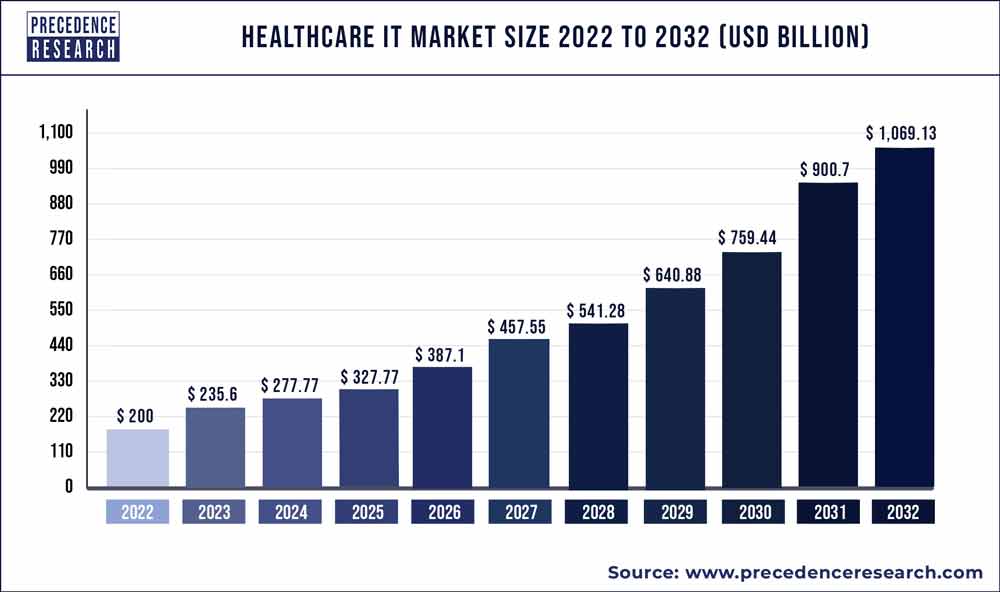The global healthcare IT market was valued at USD 200 billion in 2022 and is expected to hit around USD 1069.13 billion by 2032, poised to grow at a CAGR of 18.30% from 2023 to 2032.

The global healthcare IT global market is driven by various factors such as surge in agreement of telehealth and mHealth practices, rise in demand for quality healthcare solutions and services, increase in government initiatives to promote HCIT and surge in demand for improved patient safety and patient care. The growing disposable income, favorable government regulations, growing urban population, improved infrastructure and ease of doing business are the major factors that has augmented the growth of the global healthcare IT market. As surge in concerns towards the patient data security & safety serve as the major restraint in the healthcare IT market owing to the growth in global cyber-attacks, protecting the patient information is a huge challenge faced by the healthcare key players.
Report Highlights
- Based on the type, the healthcare provider solution segment dominated the market, garnering a market share of around 53% in 2020. This is attributed to the rise in adoption of electronic health records (EHR) and other hospital information systems by healthcare providers.
- Based on the end user, the healthcare provider segment is estimated to be the most opportunistic segment during the forecast period. This is attributed to the higher profitability, ease of operations, low operational costs that favors the growth of the healthcare IT market.
Regional Snapshot
Asia Pacific region dominated the global healthcare IT market in 2020. The presence of around 60% of the global population in the region has presented lucrative growth opportunities for the market players. Moreover, the rising government investments in the infrastructural developments, urbanization, electrification, and development of IT and telecommunications infrastructure has prominently contributed towards the growth of the Asia Pacific healthcare IT market. The rising disposable income, increased popularity of healthcare IT among the patients, improved access to the internet, and growing number of hospitals are some of the major factors that drives the market growth.
North America was the second-largest market in 2020. The North American healthcare industry is displaying transformation value-based from volume-based business. Enhanced fraud detection, quality healthcare, prevention of novel diseases and reduced length-of-stay in hospitals are the major demands put forth by providers and payers. In addition, the government is further providing payments incentive for the healthcare providers in order to use EMRs and has further taken essential actions to release data from agencies, like the FDA, Centers for Medicaid and Medicare Services, and Centers for Disease Control.
Market Dynamics
Driver: Rising use of big data
In the past many times, the capacity of electronic data produced in the market of healthcare has expanded to petabytes and terabytes, primarily owing to the digitization of clinical, executive, and fiscal information. With the volume rising nearly double every time, it’s anticipated to reach Exabyte and indeed zettabytes in the forecast period. In addition to the rising volume, the absolute diversity of healthcare data presents a various challenge for healthcare providers. In addition, the extent of the data and its diversity make healthcare data more complex market, service providers are decreasingly opting healthcare analytics and data management solutions.
Restraint: IT infrastructural constraints in developing countries
Cost issues are one of the major barriers to the adoption of healthcare IT solution. The software updating and maintenance costs of these systems are more than the price of the software. Support and conservation services, which comprise of software upgrades as per altering requirement of the user, represent a recreating expenditure amounting to nearly 30% of the total cost of ownership. Also, the absence of internal IT expertise in the market of healthcare makes the training necessary for end users to maximize the effectiveness of numerous healthcare IT solutions thereby adding to the cost of power of these systems. The perpetration cost of healthcare IT solutions in healthcare systems of rising economies is even more as they also bear capital for erecting a structure demanded for enforcing healthcare IT solution. Therefore, the high cost of deployment and conservation restricts lower healthcare associations from investing in healthcare IT results, especially in the arising requests across the Latin America and Asia-Pacific.
Opportunity: Rising use of healthcare IT solutions in outpatient care facilities
In response to the growing pressures over the systems of health to lower the cost of care, the industry is shifting towards inpatient settings to reduce the care cost. Moreover, convenience is also an essential factor driving the rise of healthcare. With the rise in the number of inpatient settings and patient affluence, the demand and operation of healthcare IT results in inpatient settings will increase.
Challenge
Costly healthcare
Another rising issue in this industry is the growing cost of healthcare. In addition, healthcare is going through an extremity of cost and these impacts all the stakeholders in the value chain. This means everyone from insurance policy providers to medical medicine manufacturing companies and ultimately, patients get affected. Most essentially the rising healthcare coast resists the patients from having routine health checks and keeping the follow-ups. Therefore, it becomes delicate to help, control and cover health- related problems.